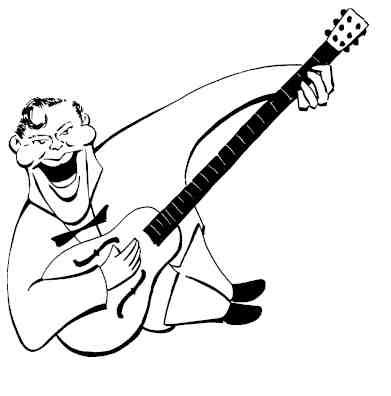Bill Haley
A Matter of Presentation

Bill Haley
Post Saddlemen
Why should we be interested in Bill Haley? Well, Bill was one of the true pioneers who helped shaped world culture as much anyone throughout history.
And no, Bill was not a philosopher or a preacher or a politician or even a college professor. Obviously he was a musician.
Bill started out as playing what we now call country and western. But that wasn't the term commonly used at the time. The preferred phrase was hillbilly music. This was a generic term that inaccurately described several styles of music, some of which were neither from the hills or from the country.
The "hillbilly" designation, although it came to include what we call country, was originally applied to "old time(y) music" or perhaps "bluegrass". But the rather derogatory nature of the word gradually led to its disuse, although you still see it in books about the history of popular music.
Bill's group was called "The Saddlemen", and they dressed like cowboys - or rather what motion pictures told us cowboys dressed like. Sporting modern Stetson hats, neckties that were really handkerchiefs, and sharped-toed riding boots with Cuban heels, they played music that 19th century drovers never heard much less sang.
In fact, much of the 24 sides the Saddlemen cut is indistinguishable from what was later called rock and roll. So it seems that if you swap your western garb for suits and bow ties and rename the group to something the kids would like, then hey, presto!, you're a rock and roll band.
Which is pretty much what Bill and the Saddlemen did. With their best going-to-the-prom coats and ties, they were now "Bill Haley and His Comets". But if you listen to "Sundown Boogie", "Rocking Chair on the Moon", and many of the earlier songs, it's impossible to tell if it's the Comets or the Saddlemen who are playing.
Of course, Bill's most famous song was Rock Around the Clock. This was released in 1954 when the term rock and roll was still rarely found in print (to learn more about the meteoric emergence of the phrase, you can click here). Ironically, it wasn't until a year later when the song was used for the opening of the motion picture The Blackboard Jungle - and so became linked to what was then called juvenile delinquency - that it became a hit.
We can't say that Rock Around the Clock was the first rock song, but with its emergence the whole concept of rock and roll music changed. Before then any form of up-tempo popular music recorded after 1950 was called rock and roll. Even big band artists like Tony Bennett and Count Basie were lumped in as rocker and rollers.
But suddenly the bands with the rows of saxophones and brass instruments were no longer rock and roll. They were returned to the earlier designation of swing. The same thing happened with other jazz groups while rhythm and blues became a sub-genre or even a precursor of rock.
Within ten years rock itself would fragment into "hard rock" and "soft rock". These designations would then splinter further into funk, acid rock, heavy metal, soul, folk rock, and of course many others.
Today there's almost as many brands of rock as there are bands (one informational website listed over 200 different genres). In fact, we've now returned to the thrilling days of yesteryear where if you close your eyes while you listen you can't tell if the performers are wearing western duds or futuristic body suits. Musical genres are now determined mostly by the presentation. And if we may suggest it, with the massive towering stage sets, the megascreen-displays,and the dangerously unpredictable costumes, it seems the music is now the least important part of the show
Yep. If Bill was alive, he'd be rolling over in his grave.
References
Rock Around the Clock: The Record That Started the Rock Revolution!, Jim Dawson, Backbeat Books, 2005
"Rock Around the Clock: How Bill Haley's Song Became a Hit", Martin Chilton, The Telegraph, April 17, 2016.
"Billy Haley and the Saddlemen", Hillbilly.com.
The Cambridge Companion to Pop and Rock, Simon Frith, Will Straw, and John Street, Cambridge University Press, 2001.
Ngram Viewer, Google.